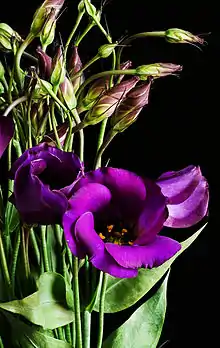Eustoma russellianum
Eustoma russellianum is a species of flowering plant in the gentian family. One of its previous binomial names was Eustoma grandiflorum.[1] Common names include showy prairie gentian, prairie gentian, Texas bluebells, Texas bluebell, bluebell,[2] and Lisianthus.
| Eustoma russellianum | |
|---|---|
 | |
| Scientific classification | |
| Kingdom: | Plantae |
| Clade: | Tracheophytes |
| Clade: | Angiosperms |
| Clade: | Eudicots |
| Clade: | Asterids |
| Order: | Gentianales |
| Family: | Gentianaceae |
| Genus: | Eustoma |
| Species: | E. russellianum |
| Binomial name | |
| Eustoma russellianum (Hook.) G.Don | |
| Synonyms | |
|
List
| |
There is a cultivar, 'Bolero Deep Blue'.[3]
Description
Eustoma russellianum has blue-green waxy leaves and showy bell shaped flowers in blue pink or white each borne singly on an upright plant. Depending on growing conditions it may present as an annual, biennial, or perennial plant.[4]
Distribution and habitat
It is found primarily in the Great Plains region of North America, from Wyoming southeast to Nebraska, and south to Texas and Mexico.[2] Due to its popularity and the frequency it is picked, it has been unable to naturally reseed itself in its native distribution.[2]
It prefers moist, sandy soils and often grows near streams, creek-beds, moist meadows, and springs.[2][4]
Cultivation
Prairie gentian is a popular garden flower, and has been cultivated in Japan for over 70 years.[2] Many varieties, including those with double petals, or a variety of colored flowers, have been developed.[2] It is not often attempted in native wildflower gardens due to its high moisture requirements and short lifespan.[4]
Diseases
| Fungal diseases | |
|---|---|
| Botrytis blight | Botrytis cinerea |
| Cercospora leaf spot | Cercospora eustomae |
| Curvularia blotch | Curvularia sp. |
| Downy mildew | Peronospora chlorae |
| Fusarium stem rot | Fusarium solani Fusarium avenaceum |
| Fusarium wilt | Fusarium oxysporum |
| Phyllosticta leaf spot | Phyllosticta sp. |
| Pythium root rot | Pythium sp. |
| Rhizoctonia stem rot | Rhizoctonia solani |
| Sclerophoma stem blight | Sclerophoma eustomis |
Viral and viroid diseases
| Viral and viroid diseases | |
|---|---|
| Bean yellow mosaic | genus Potyvirus, Bean yellow mosaic virus (BYMV) |
| Cucumber mosaic | genus Cucumovirus, Cucumber mosaic virus (CMV) |
| Impatiens necrotic spot | genus Tospovirus, Impatiens necrotic spot virus (INSV) |
| Lisianthus necrosis | Lisianthus necrosis virus (LNV) |
| Tobacco mosaic | genus Tobamovirus, Tobacco mosaic virus (TMV) |
References
- "Eustoma russellianum (Hook.) G.Don". Plants of the World Online. Royal Botanic Gardens, Kew. Retrieved 2 June 2023.
- "Eustoma exaltatum ssp. russellianum". Native Plant Database. Lady Bird Johnson Wildflower Center, University of Texas at Austin.
- "Eustoma russellianum: Novelty Plant of the Month for May 2002". Flower Council of Holland. 2002-05-01. Archived from the original on 2007-10-07.
- Barr, Claude A. (1983). Jewels of the plains : wild flowers of the Great Plains grasslands and hills. Minneapolis: University of Minnesota Press. pp. 79–80. ISBN 0-8166-1127-0.